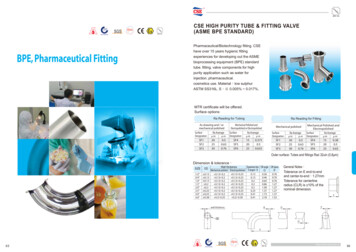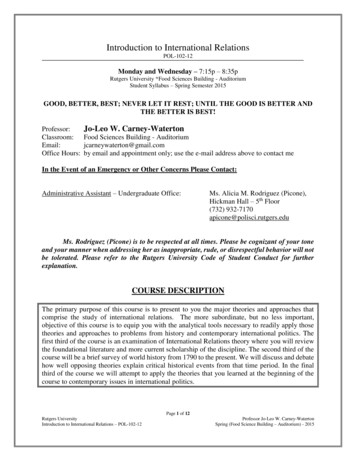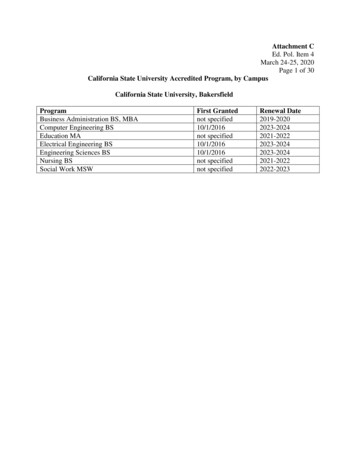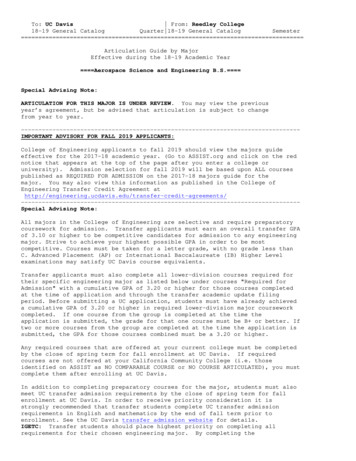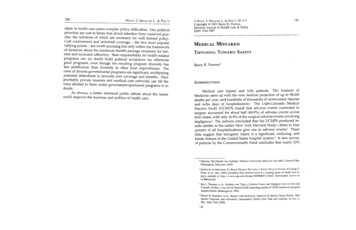
Transcription
180Hous. J. H EALTH L. & PoL 'Yalism in health care poses complex policy difficulties. Our politicalpriorities are cast in terms that divert attention from unsolved puzzles, the solutions of which are necessary for well formed policy.Cost containment and universal coverage - the two most popularrallying points - are worth pursuing but only within the frameworkof decisions about the minimum benefit package necessary for fairness and economic efficiency. State responsibility for health-relatedprograms can no doubt build political acceptance for otherwisegood programs, even though the resulting program diversity hasless justification than diversity in other local expenditures. Thecosts of diverse governmental programs are significant, multiplyingpotential defendants in lawsuits over coverage and benefits. Howprofitably private insurers and medical care networks can fill theroles allotted to them under government-sponsored programs is indoubt.As always, a better informed public debate about the issuescould improve the business and politics of health care.3 Hous. J. H EALTH L. & Po L'Y 181-217Copyright 2003 Barry R. Furrow,Houston Journal of Health Law & PolicyISSN 1534-7907181MEDICAL MISTAKES:TIPTOEING TowARD SAFETYBarry R. Furrow*INTRODUCTIONMedical care injures and kills patients. The Institute ofMedicine came up with the now familiar projection of up t 8, 00deaths per year, and hundreds of thousands of unnecessary IDJU lesand extra days of hospitalization.! The Utah-Colorado Med1calPractice Study (UCMPS) found that adverse events connected tosurgery accounted for about half (44.9%) of adverse ever:ts acr?ssboth states, with only 16.9% of the surgical adverse events mvolvmgnegligence.z The authors concluded that the UCMPS produced results similar to the earlier New York Harvard Study-three to fourpercent of all hospitalizations give rise t a :erse events:3 Thesedata suggest that iatrogenic injury is a s1gnlf1cant, endurmg, andinnate feature of the United States hospital system.4 A new surveyof patients by the Commonwealth Fund concludes that nearly 22% Director, The H ealth Law Institute, Widener University School of Law 4601 Concord Pike,Wilmington, Delaware 19803.I2INSTITUTE OF MEDICINE, To ERR IS HUMAN: BUILDING A SAFER HEALTH SYSTEM 26 (LindaT.Kohn, et al., eds., 2000) (revealing that medical error is a leading cause of death and mjury), available at http:/ /www .nap.edu / books/ 0309068371/ html / [hereinafter INSTITUTEOF MEDICINE).Eric J. Thomas, et al., Incidence and Types of Adverse Events and Negligent Care in Utah andColorado, 38 MED. CARE 247-49 (March 2000) (reporting results of 15,000 randomly samplednonpsychiatric discharges in 1992).3David M. Studdert, et al., Beyond Dead Reckoning: Measures of Medical Injury Burden, Malpractice Litigation, and Alternative Compensation Models from Utah and Colorado, 33 IND. L.REv. 1643, 1662 (2000).4Id.
182Hous. J. HEALTH L. & PoL'Yof patients have experienced a medical error, with adverse drugevents the largest contributor to these errors.sSystem failures account for the vast majority of medical errorsin hospitals. 6 Almost 80% of adverse drug events are traceable to asystem malfun.ct on. 7 Institutional staffing errors, for example, areoften the culpnt m patient injury, and long working hours may alsocontribute. 8Adverse drug events are a major contributor to iatrogenic ill ess hospita!s and y account for nearly 10% of hospitalizations. Errors m adrrurustration of drugs by nurses are often a.10P Im ry caus .Most of these drug errors are due to problems:VI h mformahon. access an dissemination. 11 In spite of the highIncidence of medical errors, It has been difficult to move quality of are onto the agend.a of most health care institutions.12 Serious qualIty problems are Widespread throughout American medicine.13The American health care system is complex.14 The federalgovernm nt fun s nearly half of the national health expendituresthrough Its Medicare and Medicaid programs, VA hospitals, and5Terance Kinninger & Lee Reeder, Establishing ROI for Technology to Reduce Medication Errorszs Both a Sczence and an Art, 57 HEALTHCARE FIN. MGMT. 46 (2003) (arguing that informationtechnology holds the potential to reduce medical errors due to hospital system failures).FURROWCHAMPUS.l 5 State governments regulate the delivery of healthcare within their boundaries. 16 And private insurers impose theirown rules on providers who choose to contract with them to offerservices. 17 One of the difficult issues to emerge from the Institute ofMedicine report, To Err Is Human, is how to achieve provider disclosure of medical errors and adverse events, as well as near missesand adverse patient events. 18 Some have proposed the developmentof a national system through which providers could voluntarily report medical errors and adverse events, but the feasibility of such asystem would be limited by providers' fears that the system wouldattract plaintiff attorneys as surely as honey attracts bears.19 Reporting of adverse events and near misses is an essential part of an information infrastructure; yet efforts to obtain good data onperformance continues to founder on the shoals of system and provider resistance. 20 We have not yet federalized medical error reporting, or quality management generally, although a federal reportingsystem would move hospitals in this direction. 21 Providers are confronted with varying regulatory forces that relate to medical errorsand their discovery. 22 No coordination of reporting is currentlymandated in our complex state-federal system, with its marketdriven insurance component and its powerful civil litigation system15See Centers for Medicare & Medicaid Services, National Health Expenditures, 2001, (reporting that the government spent 647 billion in 2001 covering 45% of the nation's health bill),at http:/ asp (last visited Apr. 19, 2003).16See generally Lucian L. Leape, Reporting of Adverse Events, 347 NEw ENG. J. MED. 1633, 163435 (2002) (noting that only twenty states have mandatory reporting systems for reportingmedical errors and few states have experts to analyze more than a small sample of suchreports) [hereinafter Adverse Events].17See generally Jonathan Harding, Risk Management in an IPA Setting, 20 PHYSICIAN ExECUTIVE32 (1994) (explaining how the development of HMOs and other health care delivery systems has given rise to new legal theories of negligence in medical error cases).1NSTITUTEOF MEDICINE, supra note 1, at 26 (reporting a study of 815 consecutive patients ata uruversity hospital).18VIRGINIA A. SHARPE & ALAN I. FADEN, MEDICAL HARM: HISTORICAL, CONCEPTUAL, ANDETHICAL DIMENSIONS OF IATROGENIC ILLNESS 188 (1998) (arguing that such errors couldprobably be reduced through improved training).See generally Adverse Events, supra note 16, at 1636 (describing various approaches to medical error reporting systems and concluding that it is doubtful that a national reportingsystem would even be feasible).19According to the American Medical Association and the American Hospital Association, ·increased liability resulting from a mandatory reporting system would deter health careproviders from reporting medical errors. Error in Medicine, supra note 14 at 1633.20Id. (arguing that among physicians, fear of lawsuits, punishment, shame, loss of reputa-678Lucien L. Leap, et a!., Systems Analysis of Adverse Drug Events, 274 J. AM. MED. Ass'N. 35(1995) (noting that as many as two-thirds of medical errors in the county may be the resultof errors m system management).Id. (reporting a system analysis of events from a prospective cohort study).See D.I. Orton & John H . Gruzelier, Adverse Changes in Mood and Cognitive Performance ofHouse Officers After Night Duty, 298 BRIT. MED. J. 21 (1989) (reporting a controlled study oftwenty doctors to determme the cognitive effects of long hours and reduced sleep).9101112183Id. at 188 (stating that computerized ordering systems could help to reduce the incidenceof such errors).Ma kR. Chassin, eta!., The Urgent Need to Improve Health Care QualiflJ, 280 J. AM. MED.AssN. 1003 (1998) (stating that present quality improvement efforts are "sporadic at best").13See generally id.14Some have even rgued that, given the complexities of the modern health care system,high rates of medical error should not be surprising at all. See Lucian L LE·· eape, rror znM d. · 272 J AM Me zczne,·· ED. Ass'N. 1851, 1851 (1994) [hereinafter Error in Medicine].tion, and peer disapproval are deterrents to disclosure of medical errors).2122See id. at 1636 (stating that while some believe a national system would improve the healthcare system it is doubtful that a national system would be feasible in the United States dueto the enormous cost and technical challenges such a system would require) .System wide programs (e.g., the Veterans Affairs program) and specialty-based reportingprograms (e.g., those for neonatal and adult intensive care) provide effective oversight,which some commentators have argued should be expanded. !d. at 1637.
Hous. J. HEALTH L. & PoL'Y184existing in parallel.23 In this article I will briefly consider some possible sources of medical error, using recent malpractice cases to illustrate the often-chaotic environment of hospitals. I will thenconsider various approaches to the problem, in light of the momentum built by the Institute of Medicine report, To Err is Human, andearlier work on medical error by Lucian Leape and others, whichdrew attention to the level of errors within health care institutions.Finally, I will compare the JCAHO and CMS approaches to reporting of medical errors with the new Pennsylvania approach, to bettergauge their merits of the approaches.Pennsylvania has enacted legislation, entitled the Medical CareAvailability and Reduction of Error Act (Mcare), that requiresmandatory reporting for not only medical errors and serious adverse events, but even requires providers to report "near misses."24This Act promises to achieve some of the system self-scrutiny thatInstitute of Medicine has recommended.zsI.AccouNT ABILITY WITHIN CoMPLEX SYsTEMs: WHOMSHOULD WE BLAME?[T]here are distinct limitations to the industrial cure, however necessary its emphasis on systems and structures. It would be deadlyfor us, the individual actors, to give up our belief in human perfectibility . .It's a necessary part of good medicine, even in superbly"optimized" systems. Operations like that lap chole have taughtme how easily error can occur, but they've also showed me something else: effort does matter; diligence and attention to the minutest details can save you.26FuRROWinto the health care setting. 27 My question is one a regulator wouldask-how can state or federal law optimize incentives within healthcare institutions to reduce medical error? The answers are by nomeans obvious, but a look at some of what we know about systemsmay provide guidance in shaping future regulatory strategies.A.Blaming the Individual ProviderThe various legal strategies for pinpointing errors and accountability in health care have historically focused on the individualphysician, the primary decision-maker who diagnoses and treats anindividual patient. 28 This is understandable given the dominant29role that the doctor-patient relationship plays in health care ethics.Until recently, malpractice suits were almost exclusively broughtagainst individual physicians, only reaching institutions throughagency law principles or under special circumstances. 30 Moreover,medical discipline is defined by the licensing power of state medicalboards over individual physicians, not institutions. 31 Thus, regulation has typically started with the individual provider. Physicianaccountability and blaming pervades our legal assessment of medical errors, and many regulatory initiatives have stumbled on physi-27A movement to restructure health care systems has developedover the past decade, driven by evidence that change is bestachieved by a focus on system-wide rather than individual providererror. Total quality management and continuous quality improvement are two examples of borrowing from industry and importationSee, e.g., Jim Summers & Michael Nowicki, Managing Organizational Improvement in a Resource-Challenged Environment, 57 HEALTHCARE FIN. MGMT. 60 (2002) (describing howhealthcare managers have implemented a variety of major organizational-improvementtechniques).2825See 40 P.S. § 1303.301 (2002) (stating that the Act "relates to the reduction of medical errorsfor the purpose of ensuring patient safety").26 ATUL GAWANDE, COMPUCATIONS: A SURGEON'S NOTES ON AN iMPERFECT SciENCE 73 (2002).See Mark A. Hall, Law, Medicine, and Trust, 55 STAN. L. REv. 463,469 (2002) (discussing the ·psychology of trust in medical relationships).'23 Jd.See 40 P.S. § 1303.308(a) (2002) (requiring provider to report a serious event or incidentthat the provider reasonably believes has occurred); See also 40 P.S. § 1303.302(a) (2002)(defining "incident" as an "event, occurrence or situation involving the clinical care of apatient in a medical facility which could have injured the patient but did not either cause anunanticipated injury or require the delivery of additional health care services to the patient") (emphasis added) .See generally Kenneth S. Abraham & Paul C. Weiler, Enterprise Medical Liability and TheEvolution of The American Health Care System, 108 HARV. L. REv. 381 (1994) (chronicling howcourts have gradually developed measures of hospital liability since the 1960s).292418530See Abraham & Weiler, supra note 28, at 393 (noting that when physicians enter into contract with a hospital to deliver emergency care, radiology services, or similar services offered by the hospital, then the hospital is likely liable for any malpractice attributable tophysicians acting as its agent. "Special circumstances" that may also result in a hospitalbeing held liable for a physician's negligence might exist if a hospital is negligent in granting privileges to a negligent physician).31See Ross D. Silverman, Regulating Medical Practice In The Cyber Age: Issues And ChallengesFor State Medical Boards, 26 AM. J.L. & MED. 255,256-58 (2000) (describing the regulation ofthe practice of medicine).
186Hous. J. HEALTH L. & PoL'Ycian fears of blame attribution. 32 Physicians agree that our "cultureof blame" has had a negative effect on how they practice.33The problem is that medicine has become far more complexthan Norman Rockwell imagined. The modem health care systemis big business and includes not only physicians, but drug and device manufacturers and their middlemen, pharmacies, testing labs,and thousands of allied health professionals supporting the wholemedical enterprise. The courts are beginning to acknowledge theinterdependence of providers within health systems, sometimes expanding duties as a result. 34 New regulatory initiatives likewise areshifting the focus to system-wide error detection and prevention,recognizing that the health care system is susceptible to system improvement ideas drawn from other industries. 35One of the major issues in medical error reduction is how toinduce physicians to change. 36Are courts, medical boards, and others who evaluate medicalerrors signaling that incentives are in place to produce duties thatare constructive for providers? My hypothesis is that we do in factwant to "blame" systems-institutions and drug and device manufacturers-since attribution of "blame" is a way of sharpening institutional accountability. In even the most industrialized model ofmedicine, blaming, when properly done, serves a v9-luable function32See Bryan A. Liang, The Adverse Event of Unaddressed Medical Error: Identifi;ing and Filling theHoles in Health-Care and Legal Systems, 29 J.L. MED. & ETHICS 346, 360 (2001) (arguing that,not only does the fear of punishment not reduce mistakes, but it also hinders cooperativeapproaches to reduce efforts through reporting).33CoMMON GooD, Harris Interactive's Fear of Litigation Study: Executive Summary, at http: / Iourcommongood.com/news/item?item id 3244 (reporting that fifty-one percent of physicians believe that, as a result of medical malpractice fears, their ability to care for patientshas gotten worse over the past five years).34See Abraham & Weiler, supra note 28, at 393.35See generally, Richard Grol, Improving the Quality of Medical Care: Building Bridges AmongProfessional Pride, Payer Profit, and Patient Satisfaction, 286 JAMA 2578 (2001) (discussingregulatory and management approaches for improving the quality of the American healthcare system).36Physicians say they have changed their behavior out of fear of being sued. See, CommonGood, Harris Interactive's Fear of Litigation Study: Executive Summary, at http: / /ourcommongood.com/news/item?item id 3244. Fifty-one percent said they suggested invasiveprocedures such as biopsies to confirm diagnoses more often then their professional judgment would dictate; 50% said they noticed other physicians resorting to aggressive treatments of terminally ill patients; 79% said they ordered more tests than they believed weremedically necessary; and 74% referred patients to specialists more often than they believedmedically necessary. Id. These data indicate that litigation does induce change, but ratherunsystematically. Some of this behavior may be positive, however, since many of thesepractice patterns may do more good than harm.187FURROWin searching out, clarifying, and holding responsible the causalagents of harm. Blame connotes moral responsibility, and we wantour health care institutions to be held accountable for their errors.Stripping away blame may neutralize responsibility. Errors shouldmatter; blame should follow. The harder question is what to dowith such blaming to make it positive. Within the health care institution, blaming individual providers serves little constructive purpose. Error identification requires a comfortable and candidrelationship among members of a health care team, built on trustamong members that errors may be openly discussed without fearof sanction in all but the most egregious cases. Blaming individualsis often a destructive cross current in our legal approach to errorthat slows progress. 37B.Locating Medical Errors Within Systems: Codman' s VisionErnest A. Codman, the chairman of the Committee on HospitalStandardization during the early part of the twentieth century, challenged the medical community to take a more scientific approach tothe clinical practice of medicine. 38 His system-based approach hasbeen described as,[A]n 'end-result system' . .based . 'on the common-sense notionthat every hospital should follow every patient that it treats, longenough to determine whether or not the treatment has been successful, and then to inquire 'if not, why not? ' with a view topreventing similar failures in the future. 39IICodman's central idea was a complete patient record that included assessments of why a treatment was unsuccessful, includingdiscussion of errors of technical knowledge or risk; lack of surgicaljudgment; lack of care or equipment; lack of diagnostic skill; unconquerable disease; patient's refusal of treatment; calamities of surgery or accidents and complications over which doctors had nocontrol. 40 This detailed record was to serve an auditing function toevaluate, compare and establish benchmarks for the performance ofphysicians and hospitals. 41 His idea was revolutionary, aiming to .37See Error in Medicine, supra note 14 at 1851 (stating that the culture within the medicalcommunity has come to view medical errors as being indicative of negligence, whichtranslates into mistakes being unacceptable and fosters unreal expectations that physiciansmust be infallible).38SHARPE & FADEN, supra note 10, at 29.Id. at 29.394!lId. at 30.uId. at 31.
188Hous. J. HEALTH L. & PoL'Yassess a hospital's efficiency in therapeutic, outcome-based terms.To Codman, patient harm due to infections or unnecessary or inappropriate surgery was a hospital "waste product."42Unfortunately, the threat to physicians from such performancemeasurement was clear, and when the American College of Surgeons (ACS) developed their error reporting system, the analysis ofpatient outcomes and error reporting was omitted-these wereCodman's most central ideas for error reduction. 43 His work ledeventually to the Joint Commission on Accreditation of Health CareOrganizations GCAHO), which has slowly moved toward a moreoutcome-based accreditation system.44Iatrogenic harm refers to patient injury caused by a physician.45 Current systems approaches attempt to draw our attention tothe broader framework for errors within the delivery system. Abroader definition is needed to capture the reality of modern healthcare delivery: drugs, devices, hospital infections, nurses, supportstaff, technicians and all those other factors that support the ultimate doctor-patient treatment. 46 Diffusion of responsibility amongmembers of a health care team often means that instead of no onebeing responsible for harms from system failures, everyone is - everyone who could have prevented the error. 47 Sharpe and Faden describe this as the ". moral imperative behind quality improvementin the delivery of health care,"48 and propose a shift in terminologyfrom iatrogenic to comiogenic to capture this new focus on systemswithin institutions:On the assumption that errors and communication failures (and theharms associated with them) are largely preventable, quality improvement requires a concerted and systematic effort on the part ofadministrators and practitioners to identify and anticipate such failures, and to implement processes that make them less likely. It isthis broader notion of causal agency and moral accountability thatis captured in the shift from the term 'iatrogenic' - which implicates physicians alone-to the term 'comiogenic' - which implicatesall health care providers who are directly or indirectly responsiblefor the care of the patient. 4942Id.43SHARPE & FADEN, supra note 10, at 33.44Id.45Id. at 117.Id.4647Id. at 139.SHARPE & FADEN, supra note 10, at 139.49 Id. at 139.48189FuRROWThis shift in terminology does not take us far enough. We alsoneed to place medical error within the larger framework of institutional errors of all kinds. Error in medicine has been viewed assomething special, in large part because of the exalted status ofmedicine in our society and the mystique with which we surroundit.so If medicine is special, then medical error must also be special.Error in medicine thus tends to be seen as a "special case ofmedicine rather than a special case of error."51 Senders writes asfollows:The unfortunate result has been the isolating of medical errors frommuch, though not all, of the body of theory, analysis, and application that has been developed to deal with error in other fields suchas aviation and nuclear power. Because of the intensely personalnature of medicine and because of the ostensibly curative, helping,and ameliorative nature of the medical process, the consequencesof medical error are viewed with more alarm than those in manyother enterprises . Much as human behavior in a medical settingis still behavior and not medicine, human error in a medical settingis still error and not medicine. Medical error must be considered tobe the result of the expression of error in a situation in which thereare medically significant things to be done and done wrong. 52Medical errors can be grouped into three general categories interms of the human agents responsible for errors and their correction within institutions: 1) individual deficiencies; 2) system deficiencies; and 3) team deficiencies.1. Individual DeficienciesThese can be momentary lapses or long-term failures of technique or education in the health care setting, psychological or education deficits being viewed as the culprit. Malpractice litigation isphysician-specific, a hunt for deviations from a standard of care or afailure in a particular case that causes a bad patient outcome. Medical discipline likewise focuses on the individual physician and herdeviation from acceptable practice in the state in which she is licensed. Studies not surprisingly have found that physicians aregenerally more often responsible for such errors than are nurses,pharmacists or other hospital personne1. 53 The response at least to50J.W. Senders, Medical Devices, Medical Errors, and Medical Accidents, inHuMAN ERROR INMEDICINE 170-71 (Marilyn Sue Bogner ed., 1994).515253Id. at 170.ld . at 170-71.See David W. Bates, et al., Incidence and Preventability of Adverse Drug Events in HospitalizedPatients , 8 J. GEN. lNTERN. MED. 289 (1993) (reporting findings of a study which evaluatedthe incidence and preventability of adverse drug events (ADE's) and found that ADE 's
190Hous. J. HEALTH L. & PoL'Ydrug related errors has been individual strategies such as computerized order entry to eliminate errors from poor handwriting. 54 Individual deficiencies are an important aspect of error reduction, sinceeducation and training can eliminate some of these p,roblems. Asystem focus still means professional re-education, training, anddissemination of clinical guidelines and evidence-based medicine. 552.System DeficienciesThe current debate over medical errors has shifted critical discussion toward the health care delivery system-typically the hospital-and away from individual providers. The work of CharlesPerrow has stimulated the work of medical researchers in this direction. 56 Perrow developed a distinction between tightly coupled systems where "normal" accidents are predictable; and loosely coupledsystems, which tends to characterize the hospital settings. 57 Looselycoupled systems allow more flexibility for error detection and prevention; in such systems "near misses" are useful tools for preventing patient injury as error prevention pathways are developed.ssOne problem with the current enthusiasm for systems fixes is thathospital organizational systems are highly resistant to change andlinear fixes. 59 Hospitals have to commit financial and staff resourcesto error prevention, and they have completing pressures on them.60As Howard Burde writes,[h]ealthcare providers generally dislike data collection and submission because it is a time-consuming, expensive, and unproductivewere primarily the result of physician error as opposed to errors by nurses or pharmacystaff).54See generally Larry I. Palmer, Patient Safety, Risk Reduction, and the Law, 36 Hous. L. REv.1609 (1999) (discussing how system approaches can improve health care safety andFURROWexercise with no discernable direct benefit. The challenge for governments is to limit the cost and potential liability inherent in thecollection and submission of data, and to ensure the narrow focusand utility of the data to be collected.61I would extend Burde's observations a step further. Government must first mandate data collection and mandatory reporting ofmedical mistakes of all kinds, so that all hospitals have incentives torespond and face similar risks for failing to do so. Limiting the costand liability is a proper regulatory consideration, but the goal ofmandating collection and disclosure of errors is the primary one.Team Deficiencies3.Hospitals are not top-down hierarchical bureaucracies: To thecontrary, they are loosely coupled in several ways: the medtcal staffhas authority independent of the hospital administration; nursesand other allied providers are employees of the hospital; and hospital pharmacies have often been poorly integrated into patient care.The process by which physicians and other providers lea:n boutnew clinical findings, sources of error and other technologies 1s nota straightforward linear one.62 One suggestion therefore has been tofocus on teams within organizations, to view them as "self-cor.recting performance units."63Edmondson describes a "superb team" as one that has the ability to "perform as a seamless whole."64 Error rates vary across suchunits even within the same hospital. 65 In one study, unit error ratesin a drug complication study ranged from 2.3 to 23.7 errors perthousand patient days. 66 The study found that "a primary influenceon detected error rates is unit members' willingness to discuss mistakes openly."67 Edmondson writes that,[l]eadership behavior influences the way errors are hand ed, w chin turn leads to shared perceptions of how consequential 1t 1s tomake a mistake. These perceptions influence willingness to reportmistakes, and may contribute to a climate of fear or of opennessefficiency).55See generally Barry R. Furrow, Broadcasting Clinical Guidelines on the Internet: Will PhysiciansTune In? 25 AM. J. L. & MEo. 403 (1999) (discussing the benefits of clinical practice guidelines and the forces that make some physicians resistant to change).56See Amy C. Edmondson, Learning From Mistakes Is Easier Said Than Done: Group and Organizational Influences on the Detection and Correction of Human Error, 32 J. APPLIED BEHAV. SCI. 5,61Id.62See Martin Wood, eta!., Achieving Clinical Behavior Change: A Case of Becoming Indeterminate, 47 Soc. Sci. MED. 1729, 1729 (1998) (noting that transfer of evidence based medical8 (1996) (discussing the theories of sociologist, Charles Perrow).research is not linear and "may underestimate the impact of other confoundingcircumstances").s7 Id.58Id.59"Much physician resistance to guidelines and formulas, anything that can be characterizedas cookbook medicine, derives from this perspective of autonomy and virtuosity." Furrow,supra note 55, at 414.60See Howard Burde, The Implementation of Quality and Safety Measures: From Rhetoric to Reality, 35 J. HEALTH LAW 263, 274 (2002).19163Edmondson, supra note 56, at 9.64Id.65Id. at 1166Id.67Id. at 24.
192Hous. J. HEALTH L. & PoL'Ythat is likely to endure and further influen
innate feature of the United States hospital system.4 A new survey of patients by the Commonwealth Fund concludes that nearly 22% Director, The Health Law Institute, Widener University School of Law 4601 Concord Pike, Wilmington, Delaware 19803. I INSTITUTE OF MEDICINE, To ERR IS HUMAN: BUILDING A SAFER HEALTH SYSTEM 26 (LindaT.
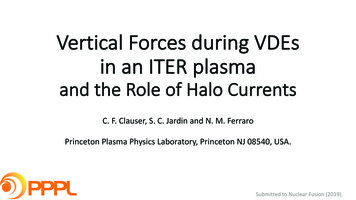
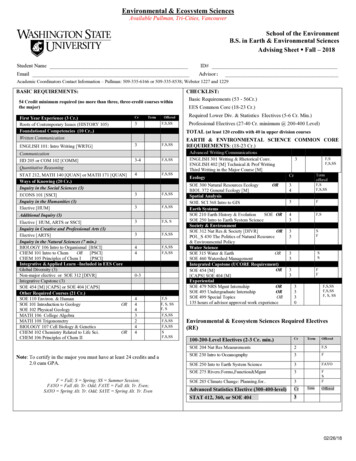
![Amalfi 180 Led Otto [28.01.22]](/img/23/022e99f7-d57e-51b4-8c41-152437a0d633.jpg)

